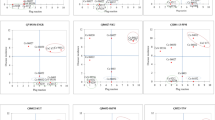Abstract
In India, red rot caused by Colletotrichum falcatum exhibits enormous variation in pathogenicity on sugarcane. The new cultivars released for commercial cultivation succumb to new pathotypes of the pathogen after some years in disease endemic regions. Due to the variability in C. falcatum, screening for red rot resistance in sugarcane progenies is being taken up with designated pathotype(s) separately for each agroclimatic regions in the country. The predominant C. falcatum pathotype of tropical India Cf671 (CF06) isolated from the then ruling cultivar CoC 671 is being used in tropical regions for disease screening. However, recently the pathotype has exhibited a reduced virulence on new cultivars and that has resulted in inconsistencies in disease reaction between artificial testing and field reaction under natural conditions. Hence, a detailed study was conducted during the past seven seasons on its pathogenicity on a set of 32 cultivars varying in red rot resistance in comparison with a new pathotype Cf94012 isolated from the cultivar Co 94012. The resistant cultivars such as BO 91, CoS 8436 and Co 98010 exhibited resistance reaction to both the pathotypes. However, other resistant cultivars such as Co 94008, Co 99006, Co 2001-15, Co 0238 and CoV 92102 showed a shift in their reaction to the new pathotype Cf94012 as moderately susceptible (MS) or susceptible (S) from resistant (R)/moderately resistant (MR) reactions in case of Cf671. Further, disease reaction on eight cultivars with MS behaviour and 11 susceptible cultivars clearly revealed a higher virulence of Cf94012 as compared to Cf671. Overall, the pathogenic behaviour of the two pathotypes during seven seasons revealed a higher virulence of Cf94012 as compared to Cf671 on resistant, moderately susceptible and susceptible cultivars. Although the pathotype Cf671 remained virulent on its host cultivar CoC 671, it could not exhibit such virulence on the cultivars developed in the recent years. Further, the study revealed that once a popular cultivar is removed from cultivation as in the case of CoC 671, the pathotype adapted to it no longer maintains its virulence, whereas the recently originated pathotype exhibits a higher virulence on the new cultivars of the host. This study also suggests adaptation of C. falcatum to the host cultivars.

Similar content being viewed by others
References
Abbott, E.V. 1933. Physiologic forms of Colletotrichum falcatum Went. Phytopathology 23: 557–559.
Beniwal, M.S., Satyavir, and K.S. Virk. 1989. Pathogenic variability in Colletotrichum falcatum incitant of red rot of sugarcane. Indian Phytopathology 42: 95–98.
Chona, B.L., and W.G. Padwick. 1942. More light on the red rot of epidemic. Indian Farming 3: 70–73.
Chona, B.L., and D.N. Srivastava. 1960. Variation in Colletotrichum falcatum Went the causal organism of red rot of sugarcane. Indian Phytopathology 13: 158–160.
De Carvalho, P.C.T. 1968. Heterokaryosis in Colletotrichum falcatum. Proceedings of International Society of Sugar Cane Technologists 13: 1251–1261.
Malathi, P., and R. Viswanathan. 2012a. Variation in Colletotrichum falcatum-red rot pathogen of sugarcane in relation to host resistance. Sugar Tech 14: 181–187.
Malathi, P., and R. Viswanathan. 2012b. Identification of pathogenicity determinants in Colletotrichum falcatum using wild and mutant cultures. Sugar Tech 14: 383–390.
Malathi, P., R. Viswanathan, and R. Jothi. 2006. Specific adaptation of Colletotrichum falcatum pathotypes to sugarcane cultivars. Sugar Tech 8(1): 54–58.
Padmanaban, P., D. Mohanraj, R. Viswanathan, M.M. Rao, N. Prakasam, R. Jothi, and K.C. Alexander. 1996. Differential interaction of sugarcane clones to pathotypes of Colletotrichum falcatum Went. Sugar Cane 4: 16–20.
Rafay, S.A., and V.B. Singh. 1957. A new strain of Glomerella tucumanensis. Current Science 26: 19–20.
Singh, P., and M.M. Payak. 1968. Observations on karyology, hyphal fusions and production of a new isolate in Colletotrichum falcatum. Acta Phytopathologica Academia Sciences (Hungary) 3: 143–155.
Srinivasan, K.V. 1962. Some observations on variation in the red rot pathogen, Glomerella tucumanensis (Speg.) Arx and Muller. Proceedings of International Society Sugar Cane Technologists 11: 795–802.
Srinivasan, K.V., and N.R. Bhat. 1961. Red rot of sugarcane—criteria for grading resistance. Journal of Indian Botanical Society 40: 566–577.
Sundara, B. 1998. Sugarcane cultivation, 292. New Delhi: Vikas Publications.
Viswanathan, R. 2010. Plant disease: Red rot of sugarcane, 301. New Delhi: Anmol Publications Pvt Ltd.
Viswanathan, R., P. Malathi, and P. Padmanaban. 2003. Variation in sugarcane red rot pathogen Colletotrichum falcatum Went. In Frontiers of fungal diversity in India, ed. G.P. Rao, C. Manoharachari, D.J. Bhat, R.C. Rajak, and T.N. Lakhanpal, 639–667. International Book Distributing Co: Lucknow.
Viswanathan, R., P. Padmanaban, and D. Mohanraj. 1997. Growing virulence of red rot pathogen of sugarcane in Tamil Nadu. Indian Sugar 47: 23–30.
Viswanathan, R., and G.P. Rao. 2011. Disease scenario and management of major sugarcane diseases in India. Sugar Tech 13: 336–353.
Viswanathan, R., and R. Samiyappan. 2000. Red rot disease in sugarcane: Challenges and prospects. Madras Agricultural Journal 87: 549–559.
Viswanathan, R., A. Ramesh Sundar, P. Padmanaban, and D. Mohanraj. 2002. Red rot disease of sugarcane and its management. In IPM systems in agriculture vol. 8 key pathogens and diseases, ed. R.K. Upadhyay, K.G. Mukherji, and O.P. Dubey, 277–301. New Delhi: Aditya Books.
Acknowledgments
The author is thankful to the Directors of the Institute for providing facilities and Technical Staffs of Plant Pathology for their assistance in conducting field experiments, data collection and culture maintenance.
Author information
Authors and Affiliations
Corresponding author
Ethics declarations
Conflict of interest
The author has no conflict of interest.
Electronic supplementary material
Below is the link to the electronic supplementary material.
Rights and permissions
About this article
Cite this article
Viswanathan, R. Pathogen Virulence in Sugarcane Red Rot Pathogen Versus Varieties in Cultivation: Classical Case of Loss in Virulence in the Pathotype CF06 (Cf671). Sugar Tech 19, 293–299 (2017). https://doi.org/10.1007/s12355-016-0458-6
Received:
Accepted:
Published:
Issue Date:
DOI: https://doi.org/10.1007/s12355-016-0458-6




